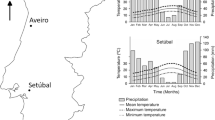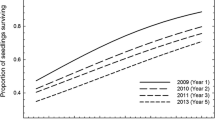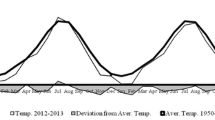Abstract
• Introduction
Shrubs are recognized as important tree regeneration niches. In this study, we experimentally analysed the effects of shrub presence, canopy cover (closed cover and open cover-gaps), and seedling size on Pinus pinaster growth.
• Objective
We expected that (1) seedling–shrub interaction would depend on seedling size and would shift from positive to negative with increasing size; (2) overstorey canopy would affect seedling–shrub interaction, with stronger and positive interactions in gaps, and (3) microsite factors would be affected by vegetation. Social status and plant size appeared to determine the post-shrub-treatment growth response.
• Results
The effect of shrub on seedling growth varied with the canopy cover. Under closed canopy, there was a shift from a positive net effect on smaller seedlings to a negative net effect on mid-size seedlings, and then back to a positive net effect on larger seedling response. Under open canopy, a negative net effect was observed, with no change in the sign of the interaction as seedling size increased. Microenvironmental conditions varied in relation to overstorey and understorey vegetation, while soil conditions varied in relation to overstorey. The seedling–shrub interaction had both positive and negative net effects, which could help define the natural regeneration dynamic of P. pinaster.



Similar content being viewed by others
References
Awada T, Radoglou K, Fotelli MN, Constantinidou HIA (2003) Ecophysiology of seedlings of three Mediterranean pine species in contrasting light regimes. Tree Physiol 23:33–41
Beckage B, Kloeppel B, Yeakly JA, Taylor SF, Coleman D (2008) Differential effects of understory and overstory gaps on tree regeneration. J Torrey Bot Soc 135:1–11
Bertness B, Callaway R (1994) Positive interactions in communities. Trends Ecol Evol 5:191–193
Bloom AJ, Chapin FS III, Money HA (1985) Resource limitation in plants—an economic analogy. Annu Rev Ecol Syst 16:363–392
Brooker RW, Maestre FT, Callaway RM, Lortie CL, Cavieres LA, Kunstler G, Liancourt P, Tielbörger K, Travis JMJ, Anthelme F, Armas C, Coll L, Corcket E, Delzon S, Forey E, Kikvidze Z, Olofsson J, Pugnaire F, Quiroz CL, Saccone P, Schiffers K, Seifan M, Touzard B, Michalet R (2008) Facilitation in plant communities: the past, the present, and the future. J Ecol 96:18–34
Callaway RM (1995) Positive interactions among plants. Bot Rev 61:306–349
Callaway RM, Walker LR (1997) Competition and facilitation: a synthetic approach to interactions in plant communities. Ecology 78:1958–1965
Callaway RM, Brooker RW, Choler P, Kikvidze Z, Lortie CJ, Michalet R, Paolani L, Pugnaire FI, Newingham B, Aschhoug ET, Armas C, Kikodze D, Cook BJ (2002) Positive interactions among alpine plants increase with stress. Nature 417:844–848
Casquet B, Montpied P, Dreyer E, Epron D, Collet C (2010) Response to canopy opening does not act as a filter to Fagus sylvatica and Acer sp. advance regeneration in a mixed temperate forest. Ann For Sci 67:105
Frazer GW, Canham CD, Lertzman KP (1999) Gap Light Analyzer (GLA), Version 2.0: Imaging software to extract canopy structure and gap light transmission indices from true-colour fisheye photographs, users manual and program documentation. Copyright © 1999. Simon Fraser University, Burnaby, British Columbia, and the Institute of Ecosystem Studies, Millbrook
Goldberg DE, Novoplansky A (1997) On the relative importance of competition in unproductive environments. J Ecol 85:409–418
Gómez-Aparicio L, Valladares F, Zamora R, Quero JL (2005) Response of tree seedlings to the abiotic heterogeneity generated by nurse shrubs: an experimental approach at different scales. Ecography 28:757–768
Grime JP (1979) Plant strategies and vegetation processes. Wiley, Chichester
Hartgerink AP, Bazzaz FA (1984) Seedling-scale environment heterogeneity influences individual fitness and population structure. Ecology 65:198–206
Holmgren M, Scheffer M, Huston M (1997) The interplay of facilitation and competition in plant communities. Ecology 78:1966–1975
Holzalpfel C, Mahall BE (1999) Bidirectional facilitation and interference between shrubs and annuals in the Mojave desert. Ecology 65:1747–1761
Kellman M, Kading M (1992) Facilitation of tree seedling establishment in a sand dune succession. J Veg Sci 3:679–688
Kitzberger T, Steinaker D, Veblen T (2000) Effects of climatic variability on facilitation of tree establishment in northern Patagonia. Ecology 81:1914–1924
Kramer PJ, Kozlowski TT (1979) Physiology of woody plants. Academic, New York, p 811
Letourneau FJ, Andenmatten E, Schlichter T (2004) Effect of climatic conditions and tree size on Austrocedrus chilensis–shrub interactions in northern Patagonia. Forest Ecol Manag 191:29–38
Liancourt P, Callaway RM, Michalet R (2005) Stress tolerance and competitive-response ability determine the outcome of biotic interactions. Ecology 86(6):1611–1618
Lortie CJ, Brooker RW, Kikvidze Z, Callaway RM (2004) The value of stress and limitation in an imperfect world: a reply to Körner. J Veg Sci 15:577–580
Maestre FT, Valladares F, Reynolds JF (2006) The stress-gradient hypothesis does not fit all relationships between plant–plant interactions and abiotic stress: further insights from arid environments. J Ecol 94:17–22
Pecot SD, Mitchell RJ, Palik BJ, Moser EB, Hilers JK (2007) Competitive responses of seedlings and understory plants in longleaf pine woodlands: separating canopy influences above and below ground. Can J For Res 37:634–648
Picon C, Guehl JM, Ferhi A (1996) Leaf gas exchange and carbon isotope composition responses to drought in a drought-avoiding (Pinus pinaster) and a drought-tolerant (Quercus petraea) species under present and elevated atmospheric CO2 concentrations. Plant Cell Environ 19:183–190
Pugnaire FI, Haase P, Puigdefabregas M, Cueto M, Clark SC, Incoll LD (1996) Facilitation and succession under the canopy of a leguminous shrub, Retama sphaerocarpa, in a semiarid environment in southeast Spain. Oikos 76:455–464
Richardson DM (1998) Ecology and biogeography of Pinus. Cambridge University Press, Cambridge, p 527
Smith TM, Huston MA (1989) A theory of the spatial and temporal dynamics of plant communities. Vegetatio 83:49–69
Tielbörger K, Kadmon R (2000) Temporal environmental variation tips the balance between facilitation and interference in desert plants. Ecology 81:1544–1553
Zhao D, Kane M, Borders BE, Harrison M, Rheney JW (2009) Site preparation and competing vegetation control affect loblolly pine long-term productivity in the southern Piedmont/Upper Coastal Plain of the United States. Ann For Sci 66:705
Acknowledgments
We thank the editor and two anonymous referees for their valuable comments on the initial version of the manuscript. Andrea Blanch revised the English. M. Juverson Boosener revised the French. Dr. Gerardo Moreno kindly revised an initial draft of the manuscript. We are grateful to the Ministerio de Ciencia e Innovación for financial support for projects AGL2001-1780, AGL2004-07094-CO2-O2 and AGL2007-65795, and for grant BES-2005-7498. We thank Pedro Abati and La Sociedad de las Navas del Marqués, S.A. for assistance with stand selection, and the Spanish Climate Agency (AEMET) for climatic data. We also thank V. Pando for statistical support, and E. Escalante, S. Bogino, C. Herrero, P. Valbuena, A. Sanz, I. Ruano, A. de Lucas, M. Gómez, Y. Pallaviccini, and J. Díez for field assistance.
Author information
Authors and Affiliations
Corresponding author
Additional information
Handling Editor: David E. Hibbs
Rights and permissions
About this article
Cite this article
Rodríguez-García, E., Ordóñez, C. & Bravo, F. Effects of shrub and canopy cover on the relative growth rate of Pinus pinaster Ait. seedlings of different sizes. Annals of Forest Science 68, 337–346 (2011). https://doi.org/10.1007/s13595-011-0039-5
Received:
Accepted:
Published:
Issue Date:
DOI: https://doi.org/10.1007/s13595-011-0039-5




